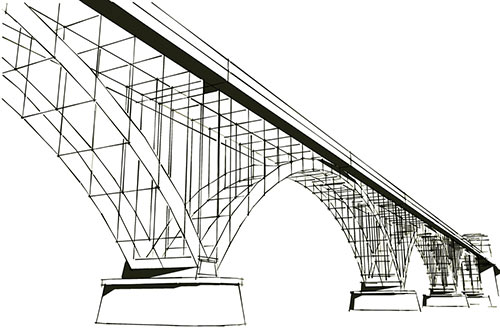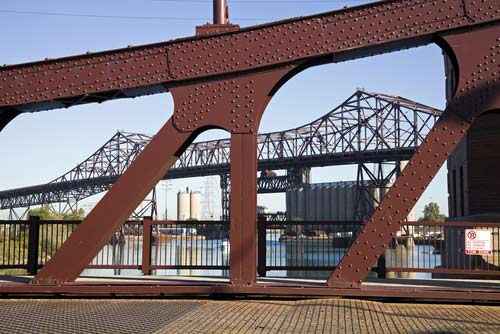Designers, engineers, architects, contractors, equipment suppliers, and others who depend on bridge-related work are always on the lookout for new projects to generate revenue. This usually involves waiting for the announcement of new opportunities to come along, bidding on them, and hoping for the best.
The issue: The number of opportunities in the pipeline has gone down over the years because of tight government budgets and limited infrastructure spending. This has made competition for bridge projects fierce.

More and more, firms that depend on bridge development and maintenance work for their livelihoods aren’t waiting for work to come to them. Instead, they’re grabbing the bull by the horns and creating opportunities themselves.
They’re doing this by using something called public private partnerships to fund bridge construction and maintenance projects. It involves finding private sources of cash (including self-funding) to pay for work that benefits the public. If a partnership is set up right, it allows the firms involved, including engineers, contractors, and equipment suppliers, to earn revenue well beyond their investment for a long time, more than they would have made if they had simply been paid directly by a government entity for their work.
Here’s everything you need to know to determine whether leveraging public private partnerships could help you take control and generate new work and revenue for your business.
What is a public private partnership?

A public private partnership (often referred to as a PPP, 3P, or P3) is a way to get projects that benefit people and municipalities done using alliances between public entities and private sector companies.
At a time when government funding and options for borrowing are limited, PPPs are being used more frequently to build bridges, upgrade them, improve and expand utility infrastructure, and do other things that benefit communities.
There are two primary reasons for using a PPP:
1. It makes it easier for governments to leverage private sector expertise, efficiencies, cutting-edge knowledge, and supplier relationships on public projects.
2. It allows public entities that need to spend money on projects to avoid borrowing, which can be inefficient for governments and negatively impact their budgets.
With a PPP, private companies use their expertise to do work for a public entity and fund the project themselves or borrow money to do so. In the end, a private entity that funds a project or borrows money for it is paid back and earns a return on their investment.
The private company is reimbursed in one of two ways:
1. They receive payments directly from end users. For example, when drivers pay bridge tolls, part of the money collected goes to pay back the private entity that built the bridge and funded the construction. Or when utility users pay their monthly bills, a portion of the money goes to the private company that installed the utility infrastructure and paid for it.
2. They receive a portion of tax revenue from the government. In other words, the local government entity diverts a portion of higher tax payments they receive that result from the improvements. For example, if a new bridge increases traffic and commerce to stores and other businesses served by it, a percentage of the tax money earned because of the increased business will pay back the private company that funded the bridge construction.
Higher use of electrical, cable, water, or other utility services that result from infrastructure improvements will also generate higher tax payments that will be used to pay back a company that funded them.
Two factors must be considered and balanced when deciding whether a PPP makes sense:
1. The cost of borrowing may be higher for a PPP than for traditional public financing because private sector firms generally pay higher interest rates than governments or public entities issuing bonds.
2. Construction, equipment rental, and other service costs will likely be lower for a PPP because of private sector efficiencies.
The public entity must decide whether the savings that come from partnering with private businesses offset the higher cost of borrowing.
How PPPs work

The formation of a public private partnership starts when a community need is identified: for example, a bridge requires improvements, a new one must be built, or utilities have to be installed across a bridge or current utility infrastructure improved or replaced.
The local government or public authority may not have enough money budgeted to do the work. Maybe they’re unable or unwilling to borrow money by issuing bonds. Perhaps they acknowledge that the work can be done better by private companies. Maybe they don’t have established relationships with material and equipment suppliers. They could identify a combination of these things.
So the public entity turns to private entities for help through a public private partnership.
The government agency or other public sector authority contracts with a private company (or companies) to do the work while assuming financial, technical, supplier, and operational risk in the project.
Typically, a single private company or group of them forms an entity called a special purpose vehicle (SPV). An SPV can include contractors, maintenance companies, equipment suppliers, investors, and others. The SPV signs the final contract with the government entity and other subcontractors to formalize the PPP. The SPV funds, develops, builds, maintains, and operates the bridge or utility for a defined period of time under the partnership.
NOTE: In some situations, the government may choose to make an investment in the project. If this is the case, it receives a proportional share in the SPV.
The benefits of a PPP

There are many benefits that result from public private partnerships. These include:
- Faster development: Because all key stakeholders are involved early in the planning and development process, it’s less likely that a project will require re-thinking or re-design. In addition, certain parts of the planning and design phases can happen concurrently, which can cut weeks or months off a project timeline. A PPP also eliminates the time-consuming RFP and bidding processes, and private sector developers usually accelerate construction so they get paid back for their investment sooner.
- Cost savings: The enhanced communication that results from a partnership reduces errors and costly mistakes. Also, duplicative inspection requirements are eliminated because they become the responsibility of the design builder and are no longer shared by the project sponsor. In addition, the shorter project timeline and other time-saving benefits usually result in significant savings.
- Shared risks: Potential risks for the project are shared between the public and private partners. The risks can be assigned to the entity better able to manage them. For example, a private sector design-build firm is better able to manage the risks associated with design quality, construction costs, and staying on schedule. A public sector government entity is better able to handle risks related to environmental issues, getting permits, and acquiring land.
- Improved quality: By involving the design team and equipment suppliers early in the project development process, they’re better able to incorporate innovative ideas and new technology into the project design and construction plan. Also, private firms in a long-term partnership are more likely to do better work because they have an ownership stake in the project and want the relationship with the government to continue.
- Stronger working relationships: Compared to working relationships started through a traditional procurement process, PPPs allow public sector agencies and private companies to develop long-term, high-trust ones. It makes it more likely that both parties will share information to develop better long-term solutions. Also, entities that work together over a long period of time become better at problem solving.
- Big-picture thinking: When projects aren’t assigned one-off, it’s more likely that government agencies and the companies they partner with will consider how projects work together in a broader infrastructure plan.
- Fewer financial constraints: Tight government budgets over the last few decades have made most municipalities think small or force them to cut out projects that benefit the public completely. The flexible funding options available through PPPs make it possible for governments to take on much needed projects and plan for bigger and better ones. PPPs are part of the reason more beautiful and inspiring bridges are being built these days.
- Higher productivity: Private sector contractors have an incentive to ensure operations are as efficient as possible in a PPP. Every dollar saved is a dollar in their pockets. In addition, private firms are generally better at managing and incentivizing subcontractors, including construction equipment suppliers, to work efficiently.
- The right contract for the right job. PPPs can be structured in many different ways. They can be used to ensure the proper resources are accessed and aligned to get the job done right.
Negatives associated with PPPs
There are some issues to look out for with PPPs as well:
- Reduced risk-taking: Private companies that are comfortable in a long-term relationship with a government agency may not want to challenge the status quo with fresh ideas. Always make sure a partnership doesn’t encourage complacency.
- Lack of fresh ideas: One of the benefits of a PPP is that it brings novel, real-world insights into the limited world of government bureaucracy. Don’t let a PPP-based relationship grow stale. Bring on new partners regularly to keep fresh ideas flowing.
- Reduced competition. PPPs eliminate the RFP and competitive bidding process. A PPP may not be the right structure for a purely cost-driven project or one with highly specific requirements.
- Fewer safety checks. One of the benefits of a PPP is that it reduces duplicative inspections and project reviews. However, it’s not a good idea to eliminate them entirely. Plan sponsors should make it a point to review project work periodically, looking out for safety and work quality issues.
Notable projects built using PPPs

The Chicago Skyway, Chicago, Illinois
The Skyway is a 7.8-mile elevated toll road connecting Chicago and suburban northwestern Indiana. It is the primary highway approaching downtown Chicago from points south and east, connecting the Dan Ryan Expressway (Interstates 90/94) to the Indiana Toll Road (Interstate 90).
This important commuter roadway could never have been rebuilt in the early part of this century without private sector participation. Today, the bridge is run by the Skyway Concession Company, LLC.
The Atlantic Station 17th Street Bridge, Atlanta, Georgia
This bridge is a critical component of a development known as Atlantic Station, located in the northwest part of downtown Atlanta. The bridge provides essential access to the site.
This highly ambitious development and the bridge that provides access to it could have never been completed with government funds alone.
Otay River Bridge, San Diego, California
The Otay River Bridge is a critical link in the South Bay Expressway, a major highway in southern San Diego County. This 12.5-mile highway was built to eliminate traffic congestion in a rapidly growing region.
The South Bay Expressway was developed by a private consortium through a public private partnership. It will be operated as a toll road during the 35-year consortium concession period. At the end of that time, ownership will revert to Caltrans.
Rialto Utility Authority, Rialto, California
Rialto’s water system faced a crisis in 2010. The infrastructure was decaying and the water supply was contaminated by a closed munitions plant. The municipal government could not afford to make improvements.
Rialto entered into a 30-year PPP with a large water processing company and a specialized investment firm. The new Rialto Water Services was able to make necessary improvements and provide safe water to the community.
How to get started
The best way to become involved with public private partnerships is to network with government officials, contractors, bridge and utility equipment suppliers, and financial professionals in your area. Do this through your local chamber of commerce, at community events, or by getting involved with your local municipal government. Find ways to build alliances with others who are interested in PPP work. In today’s era of limited government funding, you’ll find many people who want to discuss this concept.
Interested in learning more about PPPs? Check out this in-depth study by The Brookings Institute. It offers more detailed information on how PPPs can be structured and leveraged effectively for public benefit.
Don’t wait for opportunities to come to you. Public private partnerships could be a great way to generate new work for your business.

